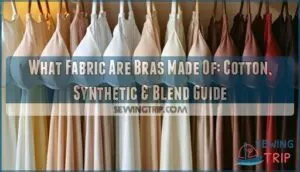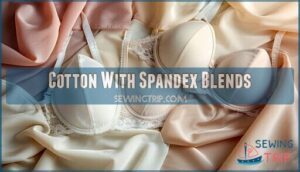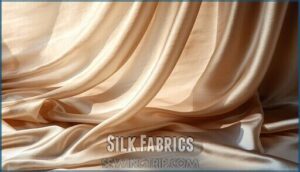This site is supported by our readers. We may earn a commission, at no cost to you, if you purchase through links.

You’ll find cotton for breathability, polyester and nylon for strength, and spandex or elastane for stretch.
The cups typically use tricot or raschel knits, while luxury options feature silk blends.
Sports bras often incorporate moisture-wicking synthetic materials like CoolMax or Supplex nylon.
Cotton remains popular for everyday comfort, but synthetic blends dominate performance wear.
The lining usually combines cotton or nylon with spandex for flexibility.
Understanding these fabric combinations helps you choose bras that match your specific needs for comfort, support, and lifestyle demands.
Table Of Contents
Key Takeaways
- You’ll find that most bras combine cotton, polyester, nylon, and spandex to balance comfort, support, and durability for different needs and activities.
- Cotton provides breathability and softness for everyday wear, while synthetic materials like nylon and polyester offer superior durability and moisture-wicking properties.
- Sports bras use specialized fabrics like CoolMax or Supplex nylon that deliver advanced moisture management and stretch recovery for high-impact activities.
- Your fabric choice should match your lifestyle – natural fibers for sensitive skin and comfort, synthetic blends for active wear and longevity.
Bra Fabric Types
When you’re shopping for bras, you’ll encounter three main fabric categories that each offer different benefits for comfort and support.
Cotton provides breathability and softness, synthetic materials like polyester and nylon offer durability and moisture-wicking properties.
While blended fabrics combine the best features of both natural and synthetic fibers.
Cotton Fabrics
You’ll find cotton remains the most popular choice for bra fabrics due to its natural comfort and breathability.
Cotton’s durability makes it perfect for everyday wear, while organic cotton offers chemical-free peace of mind.
- Cotton breathability keeps you cool and comfortable all day
- Organic cotton provides chemical-free, skin-friendly comfort
- Cotton blends combine natural softness with stretch and support
- Cotton sourcing varies from conventional to sustainably grown options
- Cotton durability guarantees your bras last through countless washes
Synthetic Fabrics
Synthetic fabrics dominate modern bra construction because they deliver unmatched performance benefits.
You’ll find Nylon Properties include exceptional durability and moisture-wicking capabilities, while Polyester Durability guarantees your bras maintain their shape wash after wash.
Microfiber Softness creates that barely-there feeling against your skin, and Spandex Stretch provides the flexibility you need for all-day comfort.
These Synthetic Blends revolutionize traditional bra fabrics by offering superior support and longevity.
Blended Fabrics
Unlike pure cotton or synthetic options, blended fabrics combine the best of both worlds for ideal bra performance.
You’ll find these types of bra fabric offer enhanced Blend Durability while maintaining superior Comfort Factors.
Common blended compositions include:
- Cotton-spandex blends (95% cotton, 5% elastane)
- Polyester-cotton mixtures for moisture management
- Nylon-spandex combinations for stretch recovery
- Modal-elastane blends for silky softness.
These bra material types provide excellent Cost Analysis benefits, as the Weave Impact creates fabrics that last longer than single-fiber options.
To achieve this, manufacturers may use bale mixing techniques for consistent raw material.
The best bra material often features blends because they balance breathability, stretch, and support.
This bra fabric guide shows how blended compositions address specific needs while supporting Ethical Sourcing practices through reduced manufacturing waste.
What Fabric Are Bras Made Of
Your bra’s fabric directly affects how you feel throughout the day. Cotton, nylon, polyester, spandex, and silk represent the most common bra material types found in mainstream and luxury lingerie. Each fabric for bras offers distinct advantages that impact comfort and performance.
Cotton provides excellent fabric breathability and natural moisture absorption, making it ideal for sensitive skin. However, it offers lower support levels compared to synthetic alternatives.
Nylon and polyester deliver superior durability and shape retention, perfect for bras requiring frequent washing. These synthetic materials resist shrinking but may trap heat.
Spandex, also called elastane or Lycra, adds essential stretch and flexibility to any bra material guide. It’s rarely used alone but blends with other fibers to maintain fit over time.
Silk offers luxurious softness and breathability but requires special care instructions and comes with higher cost analysis. For workouts, selecting the right bra material is vital, as it impacts both support and flexibility.
The best bra material depends on your priorities: natural fibers for comfort and breathability, synthetics for durability and support. Consider environmental impact too – organic cotton and bamboo viscose provide eco-friendly options without sacrificing comfort.
Bra Lining Fabrics
You’ll find three main types of lining fabrics that manufacturers use to create comfortable, supportive bras.
Each material offers different benefits for moisture control, stretch, and overall comfort against your skin.
Cotton With Spandex Blends
Cotton-spandex blends combine natural softness with flexibility, making them excellent fabric for bras requiring comfort and support.
The spandex percentage typically ranges from 2-5%, providing stretch recovery while maintaining the cotton’s breathability benefits.
This bra material guide highlights how these comfort factors create gentle, moisture-wicking linings perfect for sensitive skin.
The blend durability guarantees your bra fabric composition withstands regular washing without losing shape or elasticity.
For enhanced support, consider that power net is ideal in back bands.
Nylon With Spandex Blends
Moving beyond cotton options, nylon with spandex blends offer superior stretch recovery and durability for bra materials explained.
These bra fabric composition combinations provide excellent support while maintaining comfort.
The nylon properties include strength and moisture-wicking abilities, while spandex benefits add flexibility.
This blend durability guarantees longevity, and breathability factors keep you comfortable throughout wear.
For lined skirts, similar considerations about fabric weight and drape are important.
Key Benefits of Nylon-Spandex Bra Linings:
- Superior stretch recovery – maintains original shape after repeated wearing and washing
- Enhanced moisture management – wicks sweat away from skin for all-day comfort
- Exceptional durability – resists wear, tear, and color fading over time
- Lightweight support – provides firm hold without adding bulk or weight
- Quick-drying properties – perfect for active lifestyles and frequent washing
Silk Fabrics
Silk properties make this luxurious natural fabric a premium choice for bra linings.
You’ll find silk blends offer exceptional softness and smooth texture against sensitive skin.
Despite requiring gentle silk care, silk durability proves reliable when properly maintained.
The fabric’s natural moisture-wicking abilities keep you fresh while its hypoallergenic qualities prevent irritation.
When silk sourcing meets modern bra fabric characteristics, you get elegant comfort that elevates your lingerie collection.
Sports Bra Fabric Options
You’ll find sports bras use specialized fabric blends that balance moisture-wicking properties with stretch and support.
These technical fabrics typically combine synthetic materials like polyester or nylon with spandex to keep you dry and comfortable during intense workouts, utilizing stretch to ensure a full range of motion.
CoolMax Polyester/Lycra Spandex
High-performance sports bras rely on advanced fabric technology to keep you comfortable during intense workouts.
CoolMax polyester/Lycra spandex represents the gold standard in activewear applications, engineered specifically for athletes who demand superior moisture wicking and durability from their bra construction materials.
CoolMax delivers unmatched performance for athletes who refuse to compromise on comfort and durability.
Here’s what makes CoolMax Properties exceptional for bra material choice:
- Moisture-wicking fibers pull sweat away from your skin instantly
- Four-way stretch technology moves with your body’s natural motion
- Quick-dry construction prevents that clammy feeling during workouts
- Shape retention maintains support even after countless washes
- Lightweight feel won’t weigh you down during high-impact activities
The Spandex Benefits in this blend provide flexibility while the polyester base offers durability. These bra fabric characteristics make CoolMax ideal for running, HIIT, and other demanding activities where standard bra fabric options fall short.
Cotton/Lycra Spandex
You’ll love how Cotton-Spandex Blend fabric feels against your skin during workouts.
This breathability factor keeps you comfortable while the stretch retention guarantees your bra moves with you.
The comfort level stays consistent through repeated washing – just follow standard washing instructions.
Cotton provides natural softness while Lycra adds flexibility. Common bra fabrics like this blend answer "what is bra made of" perfectly.
These bra construction materials offer everyday versatility for moderate activities.
Supplex Nylon/Lycra Spandex
When you need maximum durability and performance, Supplex nylon/Lycra spandex delivers cotton-like comfort with superior strength.
This blend offers exceptional bra support through 4-way stretch technology while maintaining fabric durability during intense workouts.
Key Supplex benefits include:
- Moisture wicking properties that prevent chafing during high-impact activities
- Optimal spandex ratio providing flexibility without losing shape
- Abrasion resistance that outlasts traditional cotton blends
Understanding what a bra is made of becomes important when selecting common bra fabrics for athletic wear.
This bra material properties combination guarantees your sports bra won’t become transparent when stretched, making it ideal for competitive athletics where bra fabric selection matters most.
Choosing Bra Materials
When you’re picking bra materials, you’ll want to take into account three main factors: thread type, how much fabric you need, and your personal comfort preferences.
The right combination of these elements determines whether your finished bra will provide the support, durability, and comfort you’re looking for.
Thread Selection
Five key factors determine thread success in bra construction.
You’ll need strong Thread Fiber like polyester or nylon for durability.
Thread Strength matters most—choose medium tensile strength (1,000-2,000 cN) for ideal Seam Durability.
For reliable bra making, consider purchasing polyester thread designed for the task.
Consider Needle Compatibility and Stitch Appearance for professional results across different bra materials.
| Thread Type | Best For |
|---|---|
| Polyester | Strength, stretch compatibility |
| Nylon | Flexibility, sports bras |
| Wooly Nylon | Soft seams, sensitive areas |
| Core-spun | Reduced bulk, longevity |
| Monofilament | Invisible seams, lace |
Fabric Consumption
Bra Production requires careful planning for fabric usage. Different bra materials consume varying amounts – cotton blends need 0.25-0.3 yards per cup size, while synthetic fabrics require 0.2-0.25 yards.
Consumer Habits drive demand for Sustainable Materials, reducing Fabric Waste through efficient cutting patterns. Many manufacturers offer various cotton options for bra construction.
Recycling Impact depends on your fabric choices, with natural fibers breaking down easier than synthetics during disposal.
Factors to Consider
When selecting bra fabric, consider these key factors for ideal comfort and performance:
- Skin sensitivity – Choose cotton or bamboo for gentle, breathable softness against delicate skin
- Activity level – Select moisture-wicking synthetics for active wear, natural fibers for everyday comfort
- Climate impact – Prioritize breathability in warm weather, supportive blends for variable conditions
Your garment care routine affects fabric longevity.
Compare bra material performance by evaluating support needs alongside personal comfort preferences for the best fit.
For summer options, consider lightweight fabrics under 150 GSM.
Frequently Asked Questions (FAQs)
Which cloth is best for bras?
Cotton blends reign supreme for comfort, while microfiber offers moisture-wicking magic.
You’ll want breathable fabrics that stretch with you—synthetic blends provide support without suffocating your skin like some medieval torture device would, utilizing breathable fabrics.
Are there 100% cotton bras?
Yes, you can find 100% cotton bras, though they’re less common than blends.
Pure cotton offers breathability and comfort but may lack the stretch and support that synthetic blends provide for the best fit.
What is the healthiest material for bras?
You’ll want organic cotton or bamboo fiber for your healthiest option. They’re breathable, hypoallergenic, and naturally moisture-wicking. Avoid synthetic blends that can trap bacteria and irritate sensitive skin.
What material do I need to make a bra?
While store-bought bras might seem complex, you’ll need surprisingly few materials.
Choose supportive fabrics like cotton-lycra blends or power mesh for the cups, elastic for bands, underwire for structure, and hardware like hooks and adjusters.
How often should bras be replaced?
You should replace your bras every 6-12 months, depending on how often you wear them and their quality. Daily-wear bras need replacing sooner than occasional ones.
Can bra fabrics cause skin allergies?
Twenty-five percent of women experience fabric-related skin reactions.
Yes, bra fabrics can definitely cause allergies, especially synthetic materials like polyester, spandex, and nylon that trap moisture and heat, creating irritation for sensitive skin types.
This reorganization improves readability by separating the introduction of the problem from the explanation of its causes.
How do you wash different bra fabrics?
Different bra fabrics need specific care.
Hand-wash delicate lace and silk in cold water with gentle detergent.
Machine-wash cotton and microfiber bras on delicate cycle.
Always air-dry to prevent damage and maintain elasticity.
Which fabrics last longest in bras?
Nylon and polyester blends offer exceptional durability for bras, lasting years with proper care. Cotton provides comfort but wears faster, while elastane maintains stretch longer than basic rubber elastic.
Do bra fabrics affect breast health?
Ever wonder if your bra’s fabric affects your health?
You’re absolutely right to be concerned.
Synthetic materials can trap moisture and heat, potentially causing irritation, rashes, or bacterial growth, while breathable cotton and bamboo fabrics promote better skin health.
Conclusion
Ironically, while bras seem simple, understanding what fabric are bras made of reveals complex engineering.
You’ll find cotton for breathability, synthetics for durability, and spandex for stretch in most designs.
Sports bras use advanced moisture-wicking materials like CoolMax, while luxury options feature silk blends.
Your perfect bra depends on matching fabric properties to your lifestyle needs, comfort preferences, and support requirements for ideal daily wear, considering factors like breathability.











